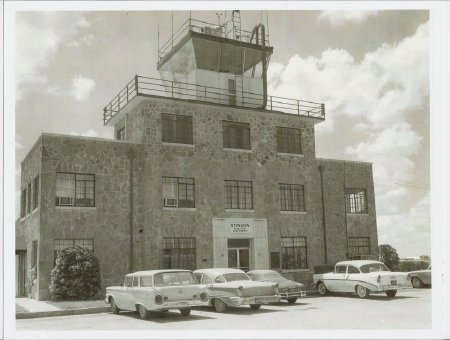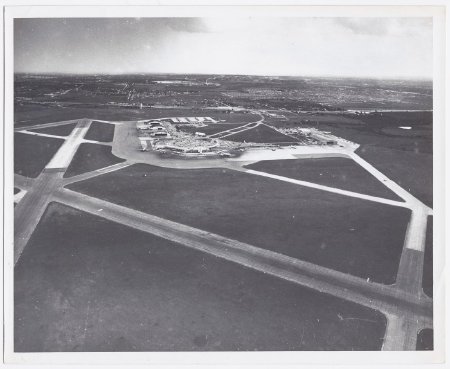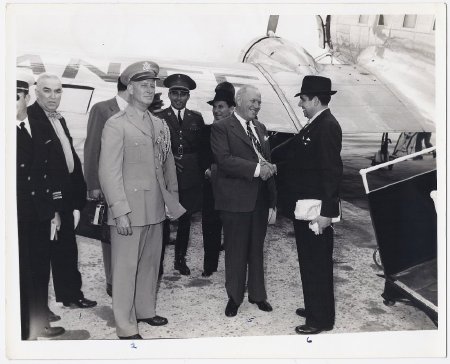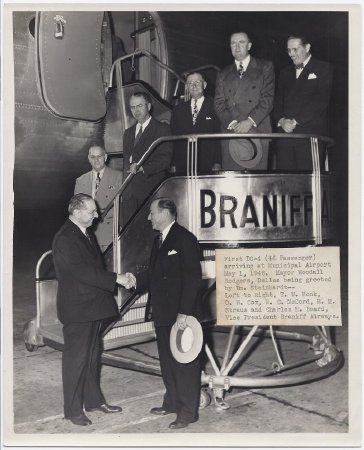An International Airport
History:
In an effort to establish more direct connections with Latin America, Mayor Maury Maverick stressed the need to make San Antonio the international port of entry for airlines flying in and out of Mexico and Latin America. The city's existing airport at Stinson Field was too small to handle large planes and heavy air traffic. In addition, it lay between the restricted military air space established for Brooks Field to the east and Kelly Field to the west.
In 1940, Maverick and other city officials made several trips to Washington D.C. to persuade the federal government to authorize money for the city to buy land and build a new airport 10 to 19 miles north of the San Antonio city limits.48 Congress agreed to provide roughly 20 percent of the cost of the new municipal airport, which would become "one of 250 [new airports across the country] provided for as a matter of national defense."49 In exchange, the city offered the federal government the use of the newly remodeled Stinson Field for military training purposes.
Groundbreaking for the new airport took place in May of 1941. However, funding problems and other wartime shortages slowed the construction, which neared completion through the combined efforts and financial contributions of the Works Progress Administration ($1,238,883), the Civil Aeronautics Authority ($100,000), the City ($550,000) and the Army ($662,118) in 1943.50 Notable architects Bartlett Cocke, Marvin Eickenroht, and Ayers & Ayers, drew up plans for the airport's administration building, which would include the control tower, passenger terminal, and offices.51
Although wartime shortages of copper and steel resulted in a redesign of the building, and ultimately delayed its construction until after the war, the airport secured a commercial contract with Braniff Airlines in 1943 and with American Airlines in 1944. The Army, which had taken over 297 acres in the northeast corner of the airport property to build Alamo Field in 1942, also leased runways and aprons at Municipal Airport for a dollar a year in 1944. By 1945, San Antonio's Municipal Airport ranked as the largest commercial airport in the U.S., beating the 1,000 acre size of the Los Angeles airport by over 230 acres!52
In 1940, Maverick and other city officials made several trips to Washington D.C. to persuade the federal government to authorize money for the city to buy land and build a new airport 10 to 19 miles north of the San Antonio city limits.48 Congress agreed to provide roughly 20 percent of the cost of the new municipal airport, which would become "one of 250 [new airports across the country] provided for as a matter of national defense."49 In exchange, the city offered the federal government the use of the newly remodeled Stinson Field for military training purposes.
Groundbreaking for the new airport took place in May of 1941. However, funding problems and other wartime shortages slowed the construction, which neared completion through the combined efforts and financial contributions of the Works Progress Administration ($1,238,883), the Civil Aeronautics Authority ($100,000), the City ($550,000) and the Army ($662,118) in 1943.50 Notable architects Bartlett Cocke, Marvin Eickenroht, and Ayers & Ayers, drew up plans for the airport's administration building, which would include the control tower, passenger terminal, and offices.51
Although wartime shortages of copper and steel resulted in a redesign of the building, and ultimately delayed its construction until after the war, the airport secured a commercial contract with Braniff Airlines in 1943 and with American Airlines in 1944. The Army, which had taken over 297 acres in the northeast corner of the airport property to build Alamo Field in 1942, also leased runways and aprons at Municipal Airport for a dollar a year in 1944. By 1945, San Antonio's Municipal Airport ranked as the largest commercial airport in the U.S., beating the 1,000 acre size of the Los Angeles airport by over 230 acres!52
About this Image:
1) 1936 terminal building at Stinson Municipal Airport, which served as city's original airport. Renovations had been completed just prior to the decision to build a larger airport north of the city and to turn Stinson over to the military. Credit: San Antonio International Airport.
2) Aerial photo taken approaching the new Municipal Airport (now San Antonio International Airport), looking southeast, c. 1950. Wetmore Road stretches from left to right across the photo behind the airport. The smoking stack of what may be the Alamo Portland and Roman Cement Company (now the Quarry Market) can be seen in the center distance.
3) Visitors and officials gather in front of a Braniff Airways plane at Alamo Field, serving as the temporary municipal airport. Standing, left to right, are: P.L. Anderson, Brigadier General C.L. Mullins; and shaking hands are Mayor Gus B. Mauermann and President Higinio Morinigo of Paraguay.
4) Passengers disembark from the first DC-4 passenger plane to land at the new Municipal Airport. Mayor Woodall Rogers of Dallas is greeted by airport manager William Steinhardt. The others are, left to right: T.W. Monk, O.W. Cox, W.C. McCord, M.M. Straus, and Charles E. Beard (vice president of Braniff Airways). Photographer: Charles Urton.
2) Aerial photo taken approaching the new Municipal Airport (now San Antonio International Airport), looking southeast, c. 1950. Wetmore Road stretches from left to right across the photo behind the airport. The smoking stack of what may be the Alamo Portland and Roman Cement Company (now the Quarry Market) can be seen in the center distance.
3) Visitors and officials gather in front of a Braniff Airways plane at Alamo Field, serving as the temporary municipal airport. Standing, left to right, are: P.L. Anderson, Brigadier General C.L. Mullins; and shaking hands are Mayor Gus B. Mauermann and President Higinio Morinigo of Paraguay.
4) Passengers disembark from the first DC-4 passenger plane to land at the new Municipal Airport. Mayor Woodall Rogers of Dallas is greeted by airport manager William Steinhardt. The others are, left to right: T.W. Monk, O.W. Cox, W.C. McCord, M.M. Straus, and Charles E. Beard (vice president of Braniff Airways). Photographer: Charles Urton.
To Learn More:
View Catalog Record (Image 3)
To learn more about the airport and aviation in San Antonio, visit this site by the Texas Transportation Museum
To learn more about the airport and aviation in San Antonio, visit this site by the Texas Transportation Museum
Credit:
Courtesy of San Antonio Conservation Society Foundation




